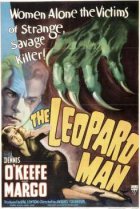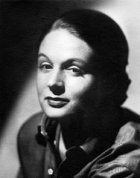
The Leopard Man Page #3
- APPROVED
- Year:
- 1943
- 66 min
- 446 Views
The CAMERA MOVES BACK and we see the wide pool at the base of
the fountain. In this pool we see Clo-Clo reflected, as she
dances.
The CAMERA PANS to take in the actual dancer and we see Clo
Clo whirling and turning in a tight circle. She is
illuminated by several baby spots concealed at the base
of the fountain, and this light makes a nimbus of light
around her. It is a sort of superaura which washes out the
background haze, leaving the dancer clear-cut and sharp in
the midst of this superaura.
As Clo-Clo's dance widens in movement, taking her to the edge
of the light nimbus, we can see her, the tables and the
patrons of El Pueblo.
The El Pueblo cafe is the smartest night club in this small
New Mexican resort town. The main dining room is in the
patio. Here are tables mantled in snowy tablecloths,
glittering candlelight and sparkling glassware. On the porch
is an open space for the performers and the orchestra on one
side On the other side is a bar.
Tonight, El Pueblo is crowded. Waiters, dressed in rather
formal costumes with black trousers and short, white coats,
scurry between the tables. A good portion of -the patrons are
in evening clothes.
Clo�Clo dances. The rhythmic rattle of her castanets beat out
above the orchestra.
Clo-Clo is New Mexican. Like the broncos of her native state,
she is all fine, proud, pure Spanish blood. It has suffered a
change in the high clear air of New Mexico. In her dance,
too, we see the more primeval strain of the Indian twisted
among the finer threads of Spanish rhythm.
She dances. In the pool we see the heavy flutter and turn of
her skirt. Her neck, her bosom, her arms, bend and sway and
turn and pulse with the bloodbeat of the castanets. She is
just entering a graceful turn of the dance, the castanets
beginning a glissade, when suddenly she stops dead, the click
of the castanets cutting off abruptly.
REVERSE SHOT - the doorway leading into the El Pueblo. Framed
in this doorway is Kiki, slim and tall in a black gown with
black gloves, and in her outstretched hand is a black leash
which links her to the leopard. Behind her the doorway is hot
with light so that we see her dramatic outline, a silhouette
against luminosity.
MED. LONG SHOT - the cafe. A buzz of amazement sounds from
the crowd. There is a flutter of astonishment and timidity.
CLOSEUP of Clo�Clo.
MED. CLOSE SHOT of Kiki. Behind her in the doorway Jerry
Manning's face appears. It is obvious that Kiki, despite her
dramatic pose, is surreptitiously nervous.
JERRY:
(sotto voce)
Don't stand here, Kiki. You're on
stage. They're looking at you.
Kiki moves majestically forward.
MED. LONG SHOT � a table near the dance space. Kiki, the
leopard moving before her, threads her way between two
tables, the patrons drawing away from her black escort as she
passes. A waiter, carefully holding the chair between him and
Translation
Translate and read this script in other languages:
Select another language:
- - Select -
- 简体中文 (Chinese - Simplified)
- 繁體中文 (Chinese - Traditional)
- Español (Spanish)
- Esperanto (Esperanto)
- 日本語 (Japanese)
- Português (Portuguese)
- Deutsch (German)
- العربية (Arabic)
- Français (French)
- Русский (Russian)
- ಕನ್ನಡ (Kannada)
- 한국어 (Korean)
- עברית (Hebrew)
- Gaeilge (Irish)
- Українська (Ukrainian)
- اردو (Urdu)
- Magyar (Hungarian)
- मानक हिन्दी (Hindi)
- Indonesia (Indonesian)
- Italiano (Italian)
- தமிழ் (Tamil)
- Türkçe (Turkish)
- తెలుగు (Telugu)
- ภาษาไทย (Thai)
- Tiếng Việt (Vietnamese)
- Čeština (Czech)
- Polski (Polish)
- Bahasa Indonesia (Indonesian)
- Românește (Romanian)
- Nederlands (Dutch)
- Ελληνικά (Greek)
- Latinum (Latin)
- Svenska (Swedish)
- Dansk (Danish)
- Suomi (Finnish)
- فارسی (Persian)
- ייִדיש (Yiddish)
- հայերեն (Armenian)
- Norsk (Norwegian)
- English (English)
Citation
Use the citation below to add this screenplay to your bibliography:
Style:MLAChicagoAPA
"The Leopard Man" Scripts.com. STANDS4 LLC, 2024. Web. 16 Apr. 2024. <https://www.scripts.com/script/the_leopard_man_896>.



Discuss this script with the community:
Report Comment
We're doing our best to make sure our content is useful, accurate and safe.
If by any chance you spot an inappropriate comment while navigating through our website please use this form to let us know, and we'll take care of it shortly.
Attachment
You need to be logged in to favorite.
Log In